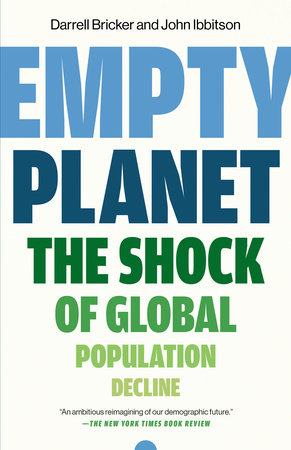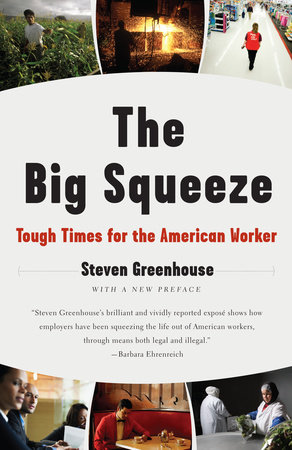A conversation with Darrell Bricker and John Ibbitson,
authors of
EMPTY PLANET: The Shock of Global Population Decline
The United Nations projects that Earth’s population will reach 11.2 billion by 2100, creating a global crisis. In EMPTY PLANET, you argue that the population will in fact start to decline by mid-century. Why do you think the UN has gotten it wrong? If the belief that population is dangerously swelling is incorrect, why have so many bought into it?
Our disagreement with the UN’s projections is about timing and extent, but not about direction. Both sides agree that the world’s population is going through a massive transformation. It’s becoming older and much more urbanized, and at some point, it will begin to decline. We think this transformation is happening more quickly and more completely than the UN does. Why is the UN missing it? In our view, it’s because their preferred model doesn’t consider the rapid changes that are taking place in how people, especially women, are choosing to live their lives these days. These changes are leading to fewer children being born, and ultimately the shrinking of the world’s population.
Why do people still buy into the overpopulation scenario? Frankly, it’s because they haven’t seriously looked at the data, or traveled around the world to see what’s really happening. We did both, which led us to a very different conclusion about what’s happening to the world’s population.
What initially drew your attention to this topic?
Both of us have written about how population change is reshaping our home country, Canada. Our curiosity led us to start looking at how Canada compared to other countries. What we saw amazed us. Not only was the rest of the developed world experiencing aging populations and significant declines in fertility, so too was the developing world. We also noticed how few people were talking about it. The collapse of the global population during the 21st century was a topic we thought a lot more people should hear about.
What are the main factors driving population decline, and why are they arising at this particular moment?
The biggest driver is urbanization. In 1960, about a third of the world’s population lived in a city. By 2050, it will increase to two-thirds. People living in cities live longer, and women living in cities have fewer kids. Sometime soon—most likely mid-century—these two conditions will lead to a tipping point, and from then on, the population will decline. It is inevitable. But what’s most interesting is how different cultural pressures in different countries are leading to the same result. That’s why traveling around the world and speaking to people on the ground was so important to really understand the story behind these trends.
In researching EMPTY PLANET, you talked to academics and public officials, students and office workers, aid workers and slum dwellers, in cities on six continents. How did you decide what places you should visit in the course of your research?
It was based on the countries that we felt were most important to the story. Over a third of the world’s population lives in China and India, so if we didn’t get those two countries right, nothing else would matter. So we visited both, and learned some amazing things. We also wanted to go to countries that had interesting statistical or cultural stories to tell. For example, Brazil’s birthrate has gone from over 6 in 1960 to just 1.8 today; we wanted to learn what accounted for that rapid change. With the U.S. immigration debate in full fury, Florida was the perfect place to investigate how migration patterns affect population trends. The UN’s projections estimate that population growth in Africa is supposed to offset all the countries with declining populations–we went to Kenya to see how likely that scenario is. What’s happened in Western Europe, where population decline has already begun? That’s why we went to Brussels. And Korea, where the birth rate is now just 1, helped us understand why birth rates are cratering in wealthy East Asian and Pacific countries.
What was the most surprising fact you came across while researching the book?
The truly dire population situation in China. Many observers are vaguely aware of the devastating impact of their one child policy, but we only had a superficial understanding of the population challenges they are facing. The one child policy was ended recently, but it hasn’t led to a higher birth rate. It’s bad, and it’s only going to get worse.
With all the environmental problems the world has, as well as poverty and scarcity of resources, a smaller population sounds like a good thing. What’s the downside? And, if the decline won’t happen for decades, why should readers today care?
The downside is that we are not only shrinking, we’re aging too. A small, old population is not a base for dynamic progress and growth. In addition, we will face enormous dependency issues that no country has really faced before. Why should readers care? Because all of this is happening right now. For example, the U.S. Census Bureau just announced that birthrate for Millennials in the U.S. has collapsed to 1.0. That’s going to put tremendous strain on the healthcare system and make it much harder for people of working age to retire in the future.
In EMPTY PLANET, you note that some of the richest places on earth—Japan, Korea, Spain, Italy, and much of Eastern Europe—are shedding people every year. How are they dealing with population decline? Is there anything countries like the U.S. and Canada can learn from their experience?
They aren’t dealing with it; they are just learning to live with it. In the short term, one obvious solution is to embrace immigration. But many of these countries have gone in the opposite direction and embraced an almost suicidal xenophobia. Both the U.S. and Canada have gained enormously from immigration. Canada, for example, has the most rapidly growing population in the G7, even though it has a birthrate of only 1.6. How? Canada brings in almost 1% of its entire population every year through a reasonably well-managed immigration system. The United States, too has tremendous potential to grow and prosper, even as its major geopolitical competitors decline, provided it does not throw up walls—metaphorical and real—to immigration.
We tend to assume that the world’s most populous countries also have the highest fertility rate. Is that an accurate assumption? What trends are you seeing in countries like India and China?
China’s fertility rate has collapsed to around 1.5. Some demographers have it even lower, especially in the cities. India’s last census suggests that their birth rate is still around 2.4. But when we were in Delhi, demographers there were telling us that it has likely declined to replacement rate, or around 2.1. What’s happening in India and China is a particularly fascinating part of EMPTY PLANET.
You offer immigration as a possible solution to population decline, but note that it can only be successful in nations that embrace multiculturalism. In countries with strong nativist sentiments, how can such a shift occur, and why is that a position that even conservatives should support?
It is difficult to see how a shift toward immigration can happen under a nativist regime. But at some point, the situation could become so untenable that it would have to be considered. Still, what we’re seeing is that many countries, like Japan, would rather diminish than embrace change. That’s good news for countries like Australia and Canada that have adopted a friendlier position on immigration. The big question for the U.S. is if it will do the same. This could be another American century if Americans can get it right.














